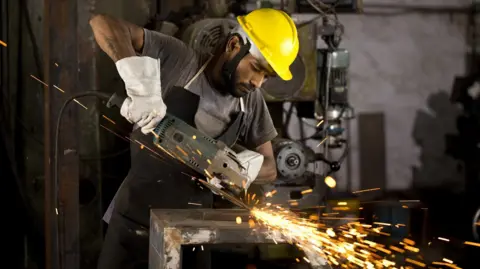 Getty Images
Getty ImagesIs the world’s fastest-growing big economy losing steam?
The latest GDP numbers paint a sobering picture. Between July and September, India’s economy slumped to a seven-quarter low of 5.4%, well below the Reserve Bank of India (RBI) forecast of 7%.
While it is still robust compared with developed nations, the figure signals a slowdown.
Economists attribute this to several factors. Consumer demand has weakened, private investment has been sluggish for years and government spending – an essential driver in recent years – has been pulled back. India’s goods exports have long struggled, with their global share standing at a mere 2% in 2023.
Fast-moving consumer goods (FMCG) companies report tepid sales, while salary bills at publicly traded firms, a proxy for urban wages, shrank last quarter. Even the previously bullish RBI has revised its growth forecast to 6.6% for the financial year 2024-2025.
“All hell seems to have broken loose after the latest GDP numbers,” says economist Rajeshwari Sengupta. “But this has been building up for a while. There’s a clear slowdown and a serious demand problem.”
Finance Minister Nirmala Sitharaman paints a brighter picture. She said last week that the decline was “not systemic” but a result of reducing government spending during an election-focused quarter. She expected third-quarter growth to offset the recent decline. India will probably remain the fastest-growing major economy despite challenges like stagnant wages affecting domestic consumption, slowing global demand and climate disruptions in agriculture, Sitharaman said.
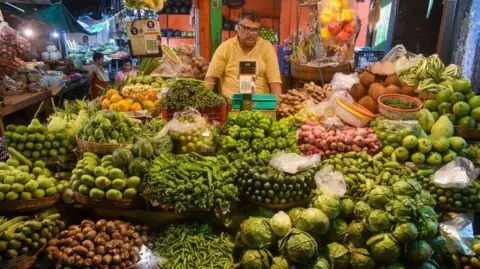 Getty Images
Getty ImagesSome – including a senior minister in the federal government, economists and a former member of RBI’s monetary policy group – argue that the central bank’s focus on curbing inflation has led to excessively restrictive interest rates, potentially stifling growth.
High rates make borrowing more expensive for businesses and consumers, and potentially reduce investments and dampen consumption, both key drivers of economic growth. The RBI has kept interest rates unchanged for nearly two years, primarily because of rising inflation.
India’s inflation surged to 6.2% in October, breaching the central bank’s target ceiling (4%) and reaching a 14-month high, according to official data. It was mainly driven by food prices, comprising half of the consumer price basket – vegetable prices, for example, rose to more than 40% in October. There are also growing signs that food price hikes are now influencing other everyday costs, or core inflation.
But high interest rates alone may not fully explain the slowing growth. “Lowering rates won’t spur growth unless consumption demand is strong. Investors borrow and invest only when demand exists, and that’s not the case now,” says Himanshu, a development economist at Delhi’s Jawaharlal Nehru University.
However, RBI’s outgoing governor, Shaktikanta Das, believes India’s “growth story remains intact”, adding the “balance between inflation and growth is well poised”.
Economists point out that despite record-high retail credit and rising unsecured loans – indicating people borrowing to finance consumption even amidst high rates – urban demand is weakening. Rural demand is a brighter spot, benefiting from a good monsoon and higher food prices.
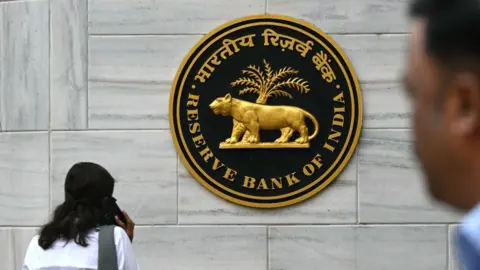 AFP
AFPMs Sengupta, an associate professor at Mumbai-based Indira Gandhi Institute of Development Research, told the BBC that the ongoing crisis was borne out by the fact that India’s economy was operating on a “two-speed trajectory”, driven by diverging performances in its “old economy and new economy”.
The old economy comprising the vast informal sector, including medium and small scale industries, agriculture and traditional corporate sector, are still waiting for long-pending reforms.
In contrast, the new economy, defined by the boom in services exports post-Covid, experienced robust growth in 2022-23. Outsourcing 2.0 has been a key driver, with India emerging as the world’s largest hub for global capability centres (GCCs), which do high-end offshore services work.
According to Deloitte, a consulting firm, over 50% of the world’s GCCs are now based in India. These centres focus on R&D, engineering design and consulting services, generating $46bn (£36bn) in revenue and employing up to 2 million highly skilled workers.
“This influx of GCCs fuelled urban consumption by supporting demand for luxury goods, real estate and SUVs. For 2-2.5 years post-pandemic, this drove a surge in urban spending. With GCCs largely established and consumption patterns shifting, the urban spending lift is fading,” says Ms Sengupta.
So the old economy appears to lack a growth catalyst while the new economy slows. Private investment is crucial, but without strong consumption demand, firms will not invest. Without investment to create jobs and boost incomes, consumption demand cannot recover. “It’s a vicious cycle,” says Ms Sengupta.
There are other confusing signals as well. India’s average tariffs have risen from 5% in 2013-14 to 17% now, higher than Asian peers trading with the US. In a world of global value chains, where exporters rely on imports from multiple countries, high tariffs make goods more expensive for companies to trade, making it harder for them to compete in global markets.
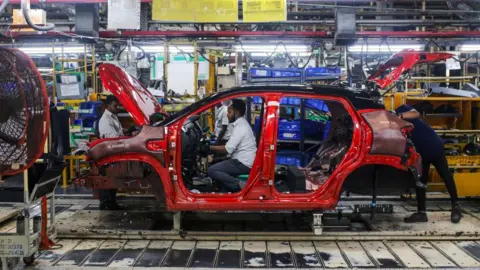 Getty Images
Getty ImagesThen there is what economist Arvind Subramanian calls a “new twist in the tale”.
Even as calls grow to lower interest rates and boost liquidity, the central bank is propping up a falling rupee by selling dollars, which tightens liquidity. Since October, the RBI has spent $50bn from its forex reserves to shield the rupee.
Buyers must pay in rupees to purchase dollars, which reduces liquidity in the market. Maintaining a strong rupee through interventions reduces competitiveness by making Indian goods more expensive in global markets, leading to lower demand for exports.
“Why is the central bank shoring up the rupee? The policy is bad for the economy and exports. Possibly they are doing it because of optics. They don’t want to show India’s currency is weak,” Mr Subramanian, a former economic adviser to the government, told the BBC.
Critics warn that the “hyping up the narrative” of India as the fastest-growing economy is hindering essential reforms to boost investment, exports and job creation. “We are still a poor country. Our per capita GDP is less than $3,000, while the US is at $86,000. If you say we are growing faster than them, it makes no sense at all,” says Ms. Sengupta.
In other words, India requires a significantly higher and sustained growth rate to generate more jobs and raise incomes.
Boosting growth and consumption will not be easy in the short term. Lacking private investment, Himanshu suggests raising wages through government-run employment schemes to increase incomes and spur consumption. Others like Ms Sengupta advocate for reducing tariffs and attracting export investments moving away from China to countries like Vietnam.
The government remains upbeat over the India story: banks are strong, forex reserves are robust, finances stable and extreme poverty has declined. Chief economic adviser V Anantha Nageswaran says the latest GDP figure should not be over-interpreted. “We should not throw the baby out with the bathwater, as the underlying growth story remains intact,” he said at a recent meeting.
Clearly the pace of growth could do with some picking up. That is why scepticism lingers. “There’s no nation as ambitious for so long without taking [adequate] steps to fulfill that ambition,” says Ms Sengupta. “Meanwhile, the headlines talk of India’s age and decade – I’m waiting for that to materialise.”
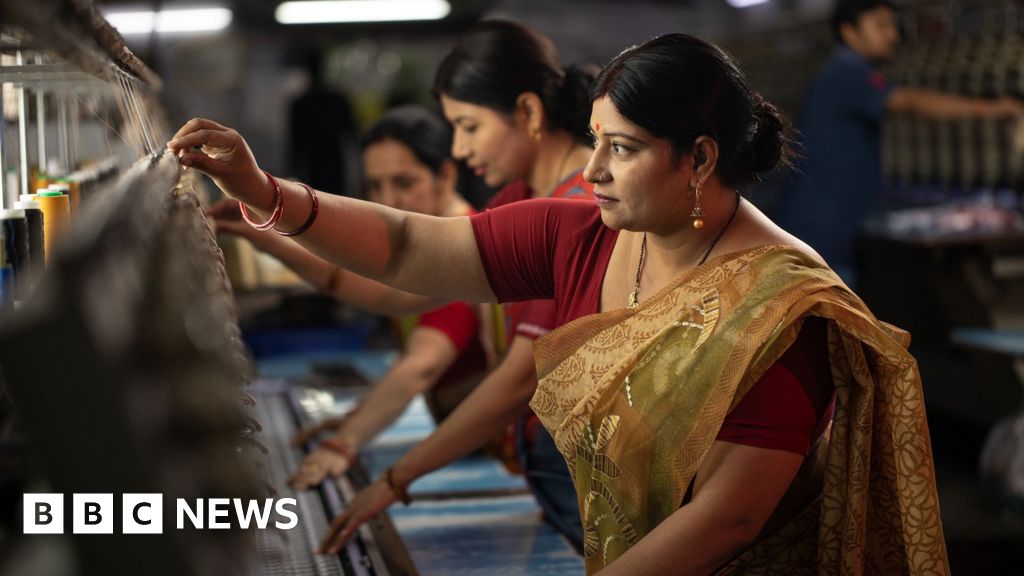

Leave a Reply